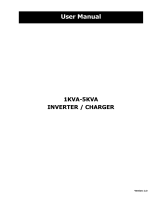
Solar MPPT Charger Manual Rev 1.1
4Limitations
•This particular device is intended for use as a solar charge controller with
a solar panel input; it will not work as a general-purpose boost converter,
as it is input controlled. If you require this, please purchase our standard
boost-converter model.
•The device should be used with panels that have an open circuit voltage
(Voc) of 55V or less, and a max power voltage of 14.5V or higher.
•There is no input current limiting. Be sure your rated panel power will
result in less than 20A maximum input current – it may damage itself if
connected to a system that continuously supplies more than 20A.
Suggested Maximum Panel Size for Safe Operaon (<20A Input)
Panel V 36V Battery 48V Battery 60V Battery 72V Battery
12V Nom. 350W 350W 350W 350W
24V Nom. 400W 400W 400W 400W
•It is not waterproof – install in a manner that avoids water exposure.
•It requires ventilation to cool properly – do not put it inside a sealed box
unless you have determined a way to cool the unit
•It does not have reverse polarity protection – you will damage
components if the battery or panels are connected in reverse.
Please note:
a) The unit is not able to source control power from the battery side, so
voltage from a solar panel must be present. You can also use a battery
on the solar input side for programming purposes only, provided that the
charger side is disconnected from any load, and it will not provide
more than 55V to the charger.
b) The charger will try and utilize all the power available from the solar
panel and thus, does not have any way of limiting the charge current that
is sunk to the battery. Because of this, you must make sure that the
maximum charger output current does not exceed your battery packs
Maximum Charge Current(or “C”) rating. Doing so will damage the
battery, and could potentially lead to a battery failure.
4






